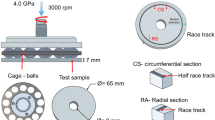Abstract
A Multi-coupling bionic steel matrix composite was fabricated using the Thermal Explosion (TE) reaction of 30 wt.% Ni-Ti-C system. The results of Scanning Electron Microscopy (SEM) and X-ray microdiffractometer investigations reveal that the reaction zone is divided into three distinct regions, i.e., Ni-TiC region, interfacial region and steel matrix region. In the Ni-TiC region, X-ray microdiffractometer tests reveal the existence of TiC and Ni phases without any intermediate phase. Observations of the interfacial regions reveal a large number of FeNi3 and a few TiC and Fe2Ti formation, which provides an essential composition gradient at the boundaries and keeps a metallurgical bonding between the Ni-TiC region and the steel matrix region. The proposed composite is hard/soft composite which combines the property of rigidity and flexibility. When it is abraded and extruded, this kind of feature shows both rigid resistance and flexible absorption. Sliding wear tests show that the wear resistance of the proposed composite is increased by about 49% in comparison with that of pure carbon steel.
Similar content being viewed by others
References
Lu Y X. Significance and progress of bionics. Journal of Bionic Engineering, 2004, 1, 1–3.
Hu T J, Shen L H, Lin L X, Xu H J. Biological inspirations, kinematics modeling, mechanism design and experiments on an undulating robotic fin inspired by Gymnarchus niloticus. Mechanism and Machine Theory, 2009, 44, 633–645.
Ren L Q. Progress in the bionic study on anti-adhesion and resistance reduction of terrain machines. Science in China Series E: Technological Sciences, 2009, 52, 273–284.
Ren L Q, Liang Y H. Biological Couplings: Classification and characteristic rules. Science in China Series E: Technological Sciences, 2009, 52, 2791–2800.
Ren L Q, Liang Y H. Biological couplings: function, characteristics and implementation mode. Science in China Series E: Technological Sciences, 2009, 53, 1–9.
Edison T L. Systems biology, integrative biology, Commentary Predictive Biology. Cell, 2005, 121, 505–506.
Paton R. Process, structure and context in relation to integrative biology. Biosystems, 2002, 64, 63–72.
Ren L Q, Cong Q, Tong J, Chen B C. Reducing adhesion of soil against loading shovel using bionic electroosmosis method. Journal of Terramechanics, 2001, 38, 211–219.
Dorozhkin S V, Epple M. Biological and medical significance of calcium phosphates. Angewandte Chemie International Edition, 2002, 41, 3130–3146.
Vukusic P, Sambles J R. Photonic structures in biology. Nature, 2003, 424, 852–855.
Barthlott W, Neinhuis C. Purity of the sacred lotus, or escape from contamination in biological surfaces. Planta, 1997, 202, 1–8.
Ren L Q, Wang Y P, Li J Q, Tong J. Flexible unsmoothed cuticles of soil animals and their characteristics of reducing adhesion and resistance. Chinese Science Bulletin, 1998, 43, 166–169.
Ren L Q, Li J Q, Chen B C. Unsmoothed surface on reducing resistance by bionics. Chinese Science Bulletin, 1995, 10, 77–80.
Mayer G. Rigid biological systems as models for synthetic composites: Materials and biology. Science, 2005, 310, 1144–1147.
Zhang Y, Zhou C H, Ren L Q. Biology coupling characteristics of mole crickets soil-engaging components. Journal of Bionic Engineering, 2008, 5 (Suppl), 164–171.
Zhou H, Chen L, Wang W, Ren L Q, Shan H Y, Zhang Z H. Abrasive particle wear behavior of 3Cr2W8V steel processed to bionic non-smooth surface by laser. Materials Science and Engineering: A, 2005, 412, 323–327.
Gao K, Sun Y H, Ren L Q, Cao P L, Li W T, Fan H K. Design and analysis of ternary coupling bionic bits. Journal of Bionic Engineering, 2008, 5 (Suppl), 53–59.
Gao F, Huang H, Ren L Q, Yu Y L. Erosive wear resistance of Laudakin stoliczkana’s ternary coupling and bionic experiments. Journal of Jilin University (Engineering and Technology Edition), 2008, 38, 86–90. (in Chinese)
Degnan C C, Shipway PH. A comparison of the reciprocating sliding wear behaviour of steel based metal matrix composites processed from self-propagating high-temperature synthesised Fe-TiC and Fe-TiB2 masteralloys. Wear, 2002, 252, 832–841.
Yang Y F, Wang H Y, Wang J G, Zhao R Y, Jiang Q C. Thermal explosion reaction behaviors between Ti and C with Ni as additive under air and Ar atmosphere. Journal of Alloys and Compounds, 2009, 486, 191–194.
Xiao G Q, Fan Q C, Gu M Z, Wang Z H, Jin Z H. Dissolution-precipitation mechanism of self-propagating high-temperature synthesis of TiC-Ni cermet. Materials Science and Engineering A, 2004, 382, 132–140.
Author information
Authors and Affiliations
Corresponding author
Rights and permissions
About this article
Cite this article
Liang, Y., Huang, H., Li, X. et al. Fabrication and Analysis of the Multi-Coupling Bionic Wear-Resistant Material. J Bionic Eng 7 (Suppl 4), S24–S29 (2010). https://doi.org/10.1016/S1672-6529(09)60213-4
Published:
Issue Date:
DOI: https://doi.org/10.1016/S1672-6529(09)60213-4




